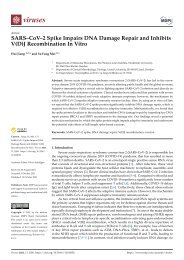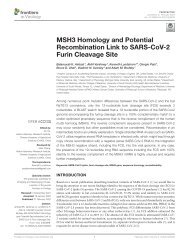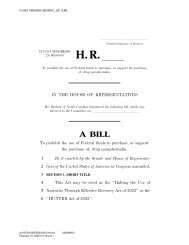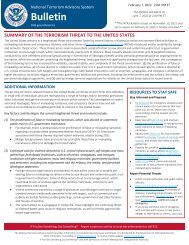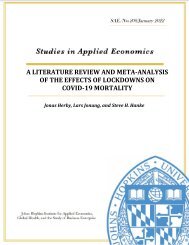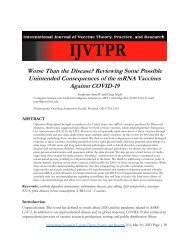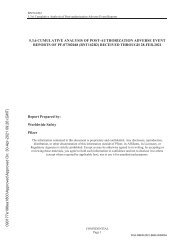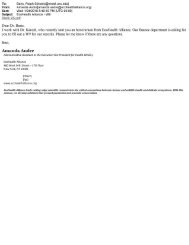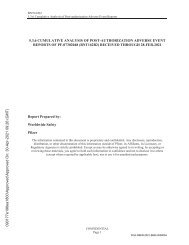Operation Trust: 1921 -1926
Create successful ePaper yourself
Turn your PDF publications into a flip-book with our unique Google optimized e-Paper software.
After the fall of the Romanov Family in 1917, Russia was thrown into a period of<br />
paranoia. The new communist government sought to weed out those still loyal to the<br />
Tsar, particularly those involved in monarchist activities, and those who were members<br />
of the White Army. The government’s fear of monarchists and other enemies of the state<br />
did not stay within the confines of Russian borders as émigrés from Russia had fled and<br />
settled all over the world, they were just as much of a risk as those still in Russia,<br />
perhaps more so as they were free to meet and plan without having to worry about<br />
repercussions from the Russian government. To combat the threat of a tsarist takeover<br />
and a return of the monarchy, Checka, under Felix Dzerzhinsky, developed a false-flag<br />
operation to lure both tsarist supporters and non-Russian foreign supporters into<br />
Russia to be dealt with. Code named <strong>Trust</strong>, the operation would span nearly a decade,<br />
fool almost everyone involve, and lead to the death or imprisonment of many people,<br />
including the British spy Sidney Reilly. This paper will examine various sources to<br />
outline the main objectives of the <strong>Trust</strong> and if those objectives were met. It will begin by<br />
outlining a previous operation by Reilly to overthrow the Bolshevik government that<br />
lead to them implementing <strong>Trust</strong>. From there the paper will outline the beginnings of<br />
<strong>Trust</strong> and how those involved were able to convince both émigrés and foreign<br />
government officials (and non-officials) that it was a legitimate organisation. Because<br />
the story of <strong>Trust</strong> is full of intricacies, this essay will confine its scope to three main<br />
areas: the creation of <strong>Trust</strong>, the literary operation involving Vasily Shulgin, and the<br />
alleged capture and execution of Sidney Reilly.
Despite TRUST not being implemented until <strong>1921</strong>, we must look earlier to<br />
understand why it was implemented. Towards the end of First World War and the<br />
murder of the Romanovs, Russia was governed by Bolsheviks who were “raised in<br />
secrecy and maturing under decades of conspiracy in their long-running struggle with<br />
the Czar’s secret police”. 1 The secrecy surrounding the Bolshevik movement was<br />
transplanted onto those who may be against them when they obtained power. Lenin<br />
stated, “What we are facing is a systematic, methodical and evidently long-planned<br />
military and financial counter-revolutionary campaign against the Soviet Republic”. 2<br />
Though it seems like paranoia, the Bolsheviks were correct in their thinking; there were<br />
plots to oust them from power. In both January and August of 1918 Lenin survived two<br />
assassination attempts. Though it was Russian socialist revolutionaries from the inside<br />
who made these attempts on Lenin’s life, the Bolshevik’s distrust of the West and<br />
émigrés were not unfounded. Prior to the attempts on his life, Lenin established a new<br />
security organisation, Cheka, under the leadership of Felix Dzerzhinsky 3 tasked with<br />
defending “the revolution and conquer the enemy even if its sword does by chance<br />
sometimes fall on the heads of the innocent”. 4 Their goal was to weed out monarchist<br />
supporters and anti-Bolsheviks, and eliminate them. 5<br />
One such outside plot was the Lockhart Plot supposedly masterminded by Robert<br />
Bruce Lockhart, then a British agent masquerading as a diplomat in Moscow, and Sidney<br />
1 Hughes-Wilson, John. The Puppet Masters: Spies, Traitors and the Real Forces Behind World Events. London: Weidenfeld & Nicolson,<br />
2004. p. 284<br />
2 Andrew, Christopher M., and Vasili Mitrokhin. The Sword and the Shield: The Mitrokhin Archive and the Secret History of the KGB, New<br />
York: Basic Books, 1999, p. 25<br />
3 Stove, R.J. " The Cheka, G.P.U and O.G.P.U: Bolshevism's Early Secret Police." National Observer no. 49 (2001), p. 17<br />
4 ibid<br />
5 Brook-Shepherd, Gordon. "Balance Sheets." In Iron Maze: The Western Secret Services and the Bolsheviks, 315-329. London: Macmillan,<br />
1998. P. 316
Reilly. 6 The alleged plot involved a disruption to food supplies that would cause civil<br />
unrest within the Russian population. The unrest would allow for the assassination of<br />
Bolshevik leaders starting with Lenin, 7 and the supposed counter-revolution set up by<br />
Reilly consisting of 60 000 White Russian officers. 8 It is unknown if the Lockhart Plot<br />
actually existed as both Britain and Russia have differing views on the actual events. 9 It<br />
should also be noted that, according to a BBC article written in 2011, that Britain has not<br />
yet declassified documents confirming the plot existed or that the documents<br />
themselves exist. 10 Lockhart himself denies playing any part in a conspiracy to<br />
overthrow the Bolshevik government, instead placing all of the responsibility upon<br />
Sidney Reilly. 11 Again, Lockhart’s original denial of his participation was questioned by<br />
his son in a letter to P.H.R. Wright of the Foreign Office in 1967 in which he said “my<br />
father himself has made it clear to me that he worked much more closely with Reilly<br />
than he had publicly indicated”. 12 Regardless of if the plot was a reality, or, as Drebo<br />
suggests, that it was Dzerzhinsky who had been the mastermind behind the plot, not the<br />
British 13 , it would be the precursor to one of the most successful false-flag operations in<br />
history.<br />
According to Natalie Grant the function and strategies of TRUST were two-fold: 1)<br />
monitor anti-Bolshevik activities occurring outside of Russia, and 2) provide avenues for<br />
6 Long, John. "Searching for Sidney Reilly: The Lockhart Plot in Revolutionary Russia, 1918." Europe-Asia Studies 47, no. 7 (1995), p.<br />
1226.<br />
7 Ibid<br />
8<br />
Knightley, Philip. "Crush The Red Terror." In The Second Oldest Profession: Spies and Spying in the Twentieth Century. London: W. W.<br />
Norton and Company, Inc., 2003. p. 71<br />
9 Drebo, R. K. "Lockhart Plot or Dzerhinskii Plot?" The Journal of Modern History 43, no. 3 (1971), p. 416<br />
10 Thomson, Mike. "Did Britain try to assassinate Lenin?" BBC World News. Last modified March 19, 2011. Accessed February 1, 2013.<br />
http://www.bbc.co.uk/news/world-12785695.<br />
11 Drebo, “Lockhart Plot”, p. 416<br />
12 Robin Lockhart to PRH Wright, Foreign Office, 9th February, 1967, Robert H.B. Lockhart Collection, Box 11 Folder: Reilly, Russian<br />
Revolution, etc.<br />
13 Drebo, “Lockhart Plot”, p. 420
“shrewdly contrived disinformation”. 14 This shrewdly contrived disinformation was<br />
prepared by a special bureau calld “Razvedupr”, who included just enough authentic<br />
information to make it believable. 15 The plan of the Bolshevik government was to gain<br />
legitimacy and recognition from Western governments, and to quell any sort of military<br />
retaliation by giving the impression that changes within Russia were happening, and<br />
they would return to being a “respectable member of the community of nations”. 16<br />
By <strong>1921</strong>, Lenin had implemented the New Economic Policy (NEP) that allowed<br />
for limited free trade and for certain Soviet representatives to travel freely throughout<br />
the West to establish economic contacts. 17 In reality, the NEP was “just a ploy in the<br />
Bolshevik power game” 18 as by <strong>1926</strong>, Stalin was firmly in power and Russia was no<br />
longer vulnerable to the White Army or monarchist supporters. 19 One NEP<br />
representative was Aleksandr Yakushev who travelled to Estonia in <strong>1921</strong> on the<br />
premise of establishing NEP ties with Western sources. Whilst in Estonia, Yakushev<br />
made contact with a man by the name of Yuri Artamanov, a monarchist supporter who<br />
had fled Russia under the Bolshevik regime. Yakushev’s reason for the visit was to drum<br />
up support for the monarchist supporters in Russia, who he said, were alive and well<br />
and lying in wait for their chance to act. 20 Artmanov bought Yakushev’s story but what<br />
he did not know was that Yakushev was working, most likely against his wishes, for<br />
CHEKA after having been imprisoned, tortured, and brainwashed into believing in the<br />
Bolshevik cause. 21 Yakushev’s real goal, under the watchful eye of Cheka, was to start the<br />
14<br />
Grant, Natalie. "Deception On A Grand Scale." International Journal of Intelligence and Counter-Intelligence 1 (1986), p. 56<br />
15 Simpkins, Patricia. "The <strong>Trust</strong>." The Security and Intelligence Foundation (1989), p. 6<br />
16<br />
Ibid<br />
17 Grant, Natalie. "Deception On A Grand Scale.", p. 53<br />
18<br />
Brook-Shepherd, Gordon. "Balance Sheets." p. 316<br />
19 Ibid<br />
20 Volkman, Ernest. "The Master Spy's Last Case: The <strong>Trust</strong> <strong>Operation</strong>." In Espionage: The Greatest Spy <strong>Operation</strong>s of the Twentieth<br />
Century. Toronto, ON: John Wiley & Sons, 1995. p. 8<br />
21 Ibid, p. 9
operation by planting pieces of information with those he knew would contact others<br />
loyal to the old regime. Artamanov, dazzled by the thought of a monarchist coup,<br />
immediately made contact with other émigrés around Europe. Unfortunately for<br />
Artamanov, the courier hired to deliver his letters was a Cheka agent. 22<br />
Perhaps the most famous figure surrounding the <strong>Trust</strong> was British spy<br />
Sidney Reilly. Born into an aristocratic family in what is now the Ukraine, he immigrated<br />
to England in the early twentieth century. Much of Reilly’s life is surrounded in mystery<br />
or classified documents, and even his real name seems to be a point of contention<br />
amongst scholars and writers. 23 Regardless of his origins, Reilly appears in England in<br />
1898 when he appears on a marriage register, and then again in 1899 when he joins the<br />
secret service. 24 What little is known about Reilly and his activities comes from his own<br />
twisting of the facts in correspondence and second-hand accounts, as well as accounts<br />
from his peers, and his last wife. 25 Whether or not Reilly actually worked for Lockhart in<br />
Russia is also a point of contention, with Lockhart changing his story at least twice, and<br />
the British government’s official position is that Reilly did supply information, but there<br />
is no evidence to support that he worked directly for Lockhart. 26 What is generally<br />
accepted is that Reilly was anti-Bolshevik, he tried to organise a coup against the<br />
Bolshevik government, and that sometime in late 1925 he made his way from Finland<br />
across the border into Russia where he was arrested. 27 What is unknown is why Reilly<br />
was such an important catch to the Soviet government. Knightley suggests that he “fell<br />
22 Ibid p. 4<br />
23<br />
Natalie Grant states Reilly’s birth name to be Sigmund Rosenblum whereas Andrew Cook states it to be Shlomo or Solomon. Even<br />
Reilly’s parents are shrouded in doubt with some accounts saying they were Gregory and Pauline Rosenblum and others saying Reilly was<br />
the product of an affair between Pauline and an unknown man, quite possibly a relative of Pauline’s. Grant, Natalie. "Deception On A Grand<br />
Scale.” p. 53, Cook, Andrew “Ace of Spies”, p. 27<br />
24 Ainsworth, John. "Sidney Reilly's Reports from South Russia, December 1918-March 1919." Europe-Asia Studies 50, no. 8 (1998), p.<br />
1447<br />
25 Grant, Natalie. "Deception On A Grand Scale.” p. 62<br />
26 Grant, Natalie. "Deception On A Grand Scale.” p. 62<br />
27 Grant, Natalie. "Deception On A Grand Scale.” p. 64
victim to the long arm and the long memory of the Cheka” 28 and there is speculation by<br />
some that he was a double agent for the Soviets all along, though this is generally not<br />
taken as fact. 29<br />
What is odd is that according to Natalie Grant, Reilly, though he had contact with<br />
émigré groups, was not even aware of the <strong>Trust</strong> until 1925. 30 After receiving a letter<br />
from a former colleague, Reilly made his way to Finland where he met with Russian<br />
agent Mariya Zakharchenko-Shultz and Nikolai Bunakov. 31 The plan was to get Reilly<br />
close to the border with Russia where he would be met by Yakushev and then enticed to<br />
cross into Russia. 32 He was taken to Moscow under the pretense of meeting with <strong>Trust</strong><br />
members, but instead was arrested and imprisoned in Lubyanka prison. 33 What<br />
happened to Reilly after that is a matter of speculation. On the 28 th of September, the day<br />
Reilly was meant to return, the Russians staged a show involving volleys of gunfire at<br />
the border with Finland. At the outcome, the Soviets started the rumour that Reilly had<br />
been shot trying to cross the border. 34 According to an interview with Boris Gudz, an<br />
OGPU officer, Reilly was imprisoned and interrogated in Lubyanka prison, and whilst he<br />
may have undergone psychological torture, Gudz maintains that there was no physical<br />
torture performed upon him. 35 Gudz states that OGPU officers killed Reilly on the night<br />
of the 5 th of November 1925 in the woods outside of Moscow as Reilly was being taken<br />
for nightly exercise.<br />
28 Knightley, Philip. "Crush The Red Terror.” p. 72<br />
29 Grant, Natalie. "Deception On A Grand Scale.” p. 62<br />
30 Grant, Natalie. "Deception On A Grand Scale.” p. 63<br />
31 Grant, Natalie. "Deception On A Grand Scale.” p. 64<br />
32 Cook, Andrew. Ace of Spies: The True Story of Sidney Reilly. Stroud: Tempus, 2004. p. 238<br />
33 Cook, Andrew. Ace of Spies. p. 242<br />
34 Cook, Andrew. Ace of Spies, p.242.<br />
35 Cook, Andrew. "To trap a spy | World news | The Guardian." The Guardian. Last modified October 7, 2002. Accessed January 31, 2013.<br />
http://www.guardian.co.uk/world/2002/oct/07/russia.artsandhumanities.
Jeffrey Richelson posits that Reilly was seen as “their [the Russian government’s]<br />
main nemesis”, 36 and that the Bolsheviks “saw his peculiar schemes to overthrow their<br />
regime as an indication, not that he was living in a fantasy world, but that there was a<br />
sophisticated SIS conspiracy approved at the highest level within Whitehall”. 37 It seems<br />
odd that for an intelligence service capable of planning, implementing, and maintaining<br />
an operation on the scale of the <strong>Trust</strong>, that they could not, or perhaps would not, see<br />
through Reilly’s grandiose claims. However, the response of the Cheka and the Russian<br />
government to Reilly could be due to their paranoia or because they had no reliable<br />
source within the British intelligence community. 38<br />
Unlike the plot surrounding Reilly, the use of Vasily Shulgin by the <strong>Trust</strong> appears<br />
to be that of a political nature. Shulgin was an anti-Bolshevik journalist and writer, and<br />
he was unwittingly used by <strong>Trust</strong> to spread propaganda and to assist in legitimizing the<br />
Soviet government. Yakushev who he met at a meeting in Berlin in 1923 introduced<br />
Shulgin to the <strong>Trust</strong>. 39 In 1925 Shulgin made his way to Russia to examine the Soviet<br />
situation for himself. What Shulgin saw was a carefully planned by his escorts who he<br />
thought were political dissidents but who were really <strong>Trust</strong> operatives. 40 His travels<br />
through the fledgling Soviet Russia were published in a book called Tri Stolitsy and<br />
served to justify Soviet activities against their own population as well as outsiders. 41<br />
What makes the case of Shulgin strange is how would an outspoken anti-Bolshevik<br />
émigré be taken in by the fake underground monarchist organisation. Shulgin’s writing<br />
36 Richelson, Jeffrey T. A Century of Spies: Intelligence in the Twentieth Century. Oxford: Oxford University Press - Kindle ed., 1995. p. 61<br />
37 Richelson, Jeffrey T. A Century of Spies p. 61<br />
38 Knightley, Philip. "Crush The Red Terror." P. 76<br />
39 Grant, Natalie. "Deception On A Grand Scale.", p. 62<br />
40 Grant, Natalie. "Deception On A Grand Scale.", p. 57<br />
41 Grant, Natalie. "Deception On A Grand Scale.” p. 67
would ultimately assist the <strong>Trust</strong> in transforming public opinion that Russia was “safe<br />
for monarchists again”. 42<br />
The success of <strong>Trust</strong> rests not only on the elaborate and deceptive practices of<br />
the Bolshevik government but also on the gullibility of those whom they deceived. 43<br />
Reilly’s disdain for the new Russian government should have, according to Knightly,<br />
disqualified him from being a representative of SIS in Russia as it “clouded his vision” 44<br />
It is impossible to determine the outcome of the <strong>Trust</strong> operation and the strength of the<br />
Soviets had Reilly not held such strong anti-Bolshevik views. The repercussions of the<br />
operation being blown open could have had detrimental effects on major historical<br />
events. Reilly was not the only one who viewed <strong>Trust</strong> and the Bolsheviks with suspicion.<br />
Admiral Hall, a British MP, stated in 1918 “a foe that is hydra-headed and whose evil<br />
power will spread over the whole world. That foe is Soviet Russia”. 45 Likewise, Polish<br />
intelligence officer Wladyslaw Michniewicz also doubted the validity of MOTsR with his<br />
suspicions being confirmed after a trip to Russia early in the <strong>Trust</strong> years. Whilst there he<br />
was struck by the vagueness of information and concluded that “<strong>Trust</strong> was an elaborate<br />
deception”. 46 Unfortunately his findings were dismissed with his superiors too blinded<br />
by the valuable intelligence they were receiving from the <strong>Trust</strong>. 47 It wasn’t until <strong>1926</strong><br />
that Michniewicz’s findings were reexamined by yet another suspicious party, Polish<br />
minister of war Marshal Pilsudski, and found to have merit. 48 At that point it was far too<br />
late as the <strong>Trust</strong> was winding down and largely unnecessary.<br />
42 Grant, Natalie. "Deception On A Grand Scale.” p. 67<br />
43 Ibid.” p. 57<br />
44 Knightley, Philip. "Crush The Red Terror." p. 60<br />
45<br />
Ibid.<br />
46 Volkman, Ernest. "The Master Spy's Last Case”, p. 13-14<br />
47 Ibid<br />
48 Ibid
If the historical documents are to be taken as fact, there is little doubt that <strong>Trust</strong>,<br />
and those involved, met their objectives. Grant has outlined various objectives tasked to<br />
<strong>Trust</strong>: want of recognition by the international community by the Bolsheviks, alleviating<br />
suspicions of Western governments, and the destruction of enemies. 49 Though Reilly and<br />
Shulgin were not the only targets of the <strong>Trust</strong>, the contrast in how they were used show<br />
a methodical plan by Cheka to infiltrate and gain a presence in various social and<br />
political circles. By eliminating Reilly, Cheka was rid of a spy with a grudge, and by<br />
duping Shulgin into printing propaganda; they were able to gain legitimacy where they<br />
may not have otherwise. The entire <strong>Trust</strong> operation would bring Russian intelligence to<br />
the forefront of the security community as one to be feared and respected. They<br />
managed to dupe almost everyone and carry on for nearly a decade, all whilst meeting<br />
their known objectives.<br />
49<br />
Grant, Natalie. "Deception On A Grand Scale.” p. 61
Bibliography<br />
Ainsworth, John. "Sidney Reilly's Reports from South Russia, December 1918-March 1919." Europe-Asia Studies 50, no. 8<br />
1470.<br />
Andrew, Christopher M., and Vasili Mitrokhin. The Sword and the Shield: The Mitrokhin Archive and the Secret History of<br />
35. New York: Basic Books, 1999.<br />
Brook-Shepherd, Gordon. "Balance Sheets." In Iron Maze: The Western Secret Services and the Bolsheviks, 315-329. Lond<br />
1998.<br />
Cook, Andrew. Ace of Spies: The True Story of Sidney Reilly. Stroud: Tempus, 2004.<br />
Cook, Andrew. "To trap a spy | World news | The Guardian." The Guardian. Last modified October 7, 2002. Accessed Janu<br />
http://www.guardian.co.uk/world/2002/oct/07/russia.artsandhumanities.<br />
Drebo, R. K. "Lockhart Plot or Dzerhinskii Plot?." The Journal of Modern History 43, no. 3 (1971): 413 - 439.<br />
Grant, Natalie. "Deception On A Grand Scale." International Journal of Intelligence and Counter-Intelligence 1 (1986): 51<br />
Hughes-Wilson, John. The Puppet Masters: Spies, Traitors and the Real Forces Behind World Events. London: Weidenfeld<br />
2004.<br />
Knightley, Philip. "Crush The Red Terror." In The Second Oldest Profession: Spies and Spying in the Twentieth Century. L<br />
Norton and Company, Inc., 2003.
Long, John. "Searching for Sidney Reilly: The Lockhart Plot in Revolutionary Russia, 1918." Europe-Asia Studies 47, no. 7<br />
1241.<br />
Richelson, Jeffrey T. A Century of Spies: Intelligence in the Twentieth Century. Oxford: Oxford University Press - Kindle e<br />
Simpkins, Patricia. "The <strong>Trust</strong>." The Security and Intelligence Foundation (1989): 1-29.<br />
Stove, R.J. " The Cheka, G.P.U and O.G.P.U: Bolshevism's Early Secret Police." National Observer no. 49 (2001): 17 - 25.<br />
Thomson, Mike. "Did Britain try to assassinate Lenin?." BBC World News. Last modified March 19, 2011. Accessed Febru<br />
http://www.bbc.co.uk/news/world-12785695.<br />
Volkman, Ernest. "The Master Spy's Last Case: The <strong>Trust</strong> <strong>Operation</strong>." In Espionage: The Greatest Spy <strong>Operation</strong>s of the T<br />
Century. Toronto, ON: John Wiley & Sons, 1995.




